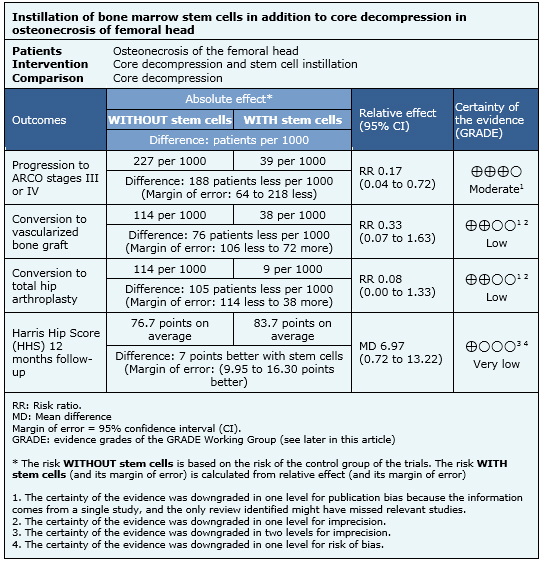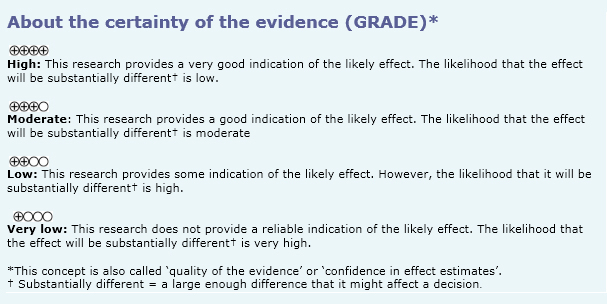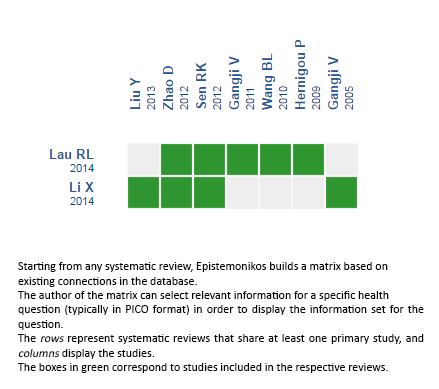 Para Descargar PDF debe Abrir sesión.
Para Descargar PDF debe Abrir sesión.
Osteonecrosis of the femoral head leads to degeneration of the head and finally to osteoarthritis of the hip. Decompression is the most widely used treatment, but its effectiveness is limited. It has been proposed instillation of stem cells in addition to decompression, would lead to better results. Searching in Epistemonikos database, which is maintained by screening 30 databases, we identified two systematic reviews including two randomized trials. We combined the evidence using meta-analysis and generated a summary of findings table following the GRADE approach. We concluded instillation of bone marrow stem cells at the time of core decompression probably slows progression to osteoarthritis of the hip in patients with osteonecrosis of the femoral head and might reduce the need of subsequent surgeries. It is unclear whether it has any effect on the functionality because the certainty of the evidence is very low.
Osteonecrosis of the femoral head mainly affects adults between the third and sixth decade of life. It has multiple causes, but it is generally produced by a severe deficiency of blood flow leading to bone necrosis and subsequent collapse of the femoral head. In the absence of early intervention with intention to preserve the native joint, there is a high risk of developing osteoarthritis of the hip.
Decompression is the most widely used treatment for avascular necrosis of the femoral head, but its effectiveness is limited.
Use of mesenchymal stem cells from adult bone marrow, in addition to decompression, would promote bone formation and neovascularization, which could improve prognosis in early stages of osteonecrosis. However, there is controversy about whether its ability to improve joint function or to increase the time until requirement of total hip arthroplasty.
We used Epistemonikos database, which is maintained by screening more than 30 databases, to identify systematic reviews and their included primary studies. With this information, we generated a structured summary using a pre-established format, which includes key messages, a summary of the body of evidence (presented as an evidence matrix in Epistemonikos), meta-analysis of the total of studies, a summary of findings table following the GRADE approach and a table of other considerations for decision-making.
|
Key messages
|
|
What is the evidence. |
We found two systematic reviews [1],[2] which included seven primary studies [3],[4],[5],[6],[7],[8],[9], two of them [3],[4], corresponded to randomized controlled trials. This table and the summary in general are based on the latter. |
|
What types of patients were included |
One study [4] included patients between 18 and 55 years of age with osteonecrosis of one or both hips stages IC to IIC according to the ARCO ( Association Research Circulation Osseous) classification with risk factors such as trauma, steroid use, alcohol abuse, Caisson disease or idiopathic aetiology (some patients had more than one cause). The other randomized study [3] included patients without specifying age with osteonecrosis of one or both femoral heads ARCO stage I or II (without subtype specification), of varied aetiologies including traumatic, steroid use, alcohol abuse, Cushing's disease, pregnancy induced and idiopathic. |
|
What types of interventions were included |
Both studies included as intervention stem cells derived from bone marrow injected into the necrotic area through a tunnel of decompression. One study [3] used a concentrate of mononuclear cells derived from bone marrow obtained from iliac crest, in doses of 5x108 cells (total mononuclear cell count). The second study [4] used mesenchymal stem cells obtained after two weeks of culture of concentrate mononuclear cells derived from bone marrow obtained from the sub trochanteric region of the affected femur at doses of 2x106 cells (total mesenchymal stem cell count). Both studies compared against core decompression alone |
|
What types of outcomes |
Harris Hip Score, progression to a more advanced stage according to ARCO classification, volume of necrotic area assessed by magnetic resonance, progression and need of vascularized bone graft or conversion to total hip arthroplasty. |
Information on the effects of instillation of stem cells at the time of core decompression in osteonecrosis of the femoral head is based on two randomized controlled trials [3],[4] including 148 cases in 133 patients. Information about progression, conversion to bone graft and conversion to total hip arthroplasty are based on one study [4]. The functionality is based on a second study [3].


|
To whom this evidence does and does not apply |
|
| About the outcomes included in this summary |
|
| Balance between benefits and risks, and certainty of the evidence |
|
| Resource considerations |
|
|
Differences between this summary and other sources |
|
| Could this evidence change in the future? |
|
Using automated and collaborative means, we compiled all the relevant evidence for the question of interest and we present it as a matrix of evidence.

Follow the link to access the interactive version: Core decompression and stem cell instillation versus core decompression alone for early stage osteonecrosis of the femoral head
The upper portion of the matrix of evidence will display a warning of “new evidence” if new systematic reviews are published after the publication of this summary. Even though the project considers the periodical update of these summaries, users are invited to comment in Medwave or to contact the authors through email if they find new evidence and the summary should be updated earlier. After creating an account in Epistemonikos, users will be able to save the matrixes and to receive automated notifications any time new evidence potentially relevant for the question appears.
The details about the methods used to produce these summaries are described here http://dx.doi.org/10.5867/medwave.2014.06.5997.
Epistemonikos foundation is a non-for-profit organization aiming to bring information closer to health decision-makers with technology. Its main development is Epistemonikos database (www.epistemonikos.org).
These summaries follow a rigorous process of internal peer review.
Conflicts of interest
The authors do not have relevant interests to declare.
 Esta obra de Medwave está bajo una licencia Creative Commons Atribución-NoComercial 3.0 Unported. Esta licencia permite el uso, distribución y reproducción del artículo en cualquier medio, siempre y cuando se otorgue el crédito correspondiente al autor del artículo y al medio en que se publica, en este caso, Medwave.
Esta obra de Medwave está bajo una licencia Creative Commons Atribución-NoComercial 3.0 Unported. Esta licencia permite el uso, distribución y reproducción del artículo en cualquier medio, siempre y cuando se otorgue el crédito correspondiente al autor del artículo y al medio en que se publica, en este caso, Medwave.

Osteonecrosis of the femoral head leads to degeneration of the head and finally to osteoarthritis of the hip. Decompression is the most widely used treatment, but its effectiveness is limited. It has been proposed instillation of stem cells in addition to decompression, would lead to better results. Searching in Epistemonikos database, which is maintained by screening 30 databases, we identified two systematic reviews including two randomized trials. We combined the evidence using meta-analysis and generated a summary of findings table following the GRADE approach. We concluded instillation of bone marrow stem cells at the time of core decompression probably slows progression to osteoarthritis of the hip in patients with osteonecrosis of the femoral head and might reduce the need of subsequent surgeries. It is unclear whether it has any effect on the functionality because the certainty of the evidence is very low.
 Autores:
Jorge Cabrolier[1,3], Marcelo Molina[2,3]
Autores:
Jorge Cabrolier[1,3], Marcelo Molina[2,3]

Citación: Cabrolier J, Molina M. Is instillation of bone marrow stem cells at the time of core decompression useful for osteonecrosis of the femoral head?. Mewave 2016;16(Suppl 1):e6406 doi: 10.5867/medwave.2016.6406
Fecha de publicación: 24/3/2016

Nos complace que usted tenga interés en comentar uno de nuestros artículos. Su comentario será publicado inmediatamente. No obstante, Medwave se reserva el derecho a eliminarlo posteriormente si la dirección editorial considera que su comentario es: ofensivo en algún sentido, irrelevante, trivial, contiene errores de lenguaje, contiene arengas políticas, obedece a fines comerciales, contiene datos de alguna persona en particular, o sugiere cambios en el manejo de pacientes que no hayan sido publicados previamente en alguna revista con revisión por pares.
Nombre/name: Luis Vidal
Fecha/date: 2016-12-21 11:17:43
Comentario/comment:
I would like to make an observation concerning this kind of review: usually, I see authors use Bone Marrow Concentrate (BMC) or Cell culture Expanded (CCE) being product completely different:
The first one is a concentrate of BM (with a frequency of mesenchymal stem cells (MSC) of 0.01 % (in the best cases) and the second one, a expanded cell culture ex vivo, with a MSC purity > 95 %. In the other hand, the dose of MSC in a BMC treatment is about 5000-1000 MSC total, while in the case of expanded culture, a typical dose is 50E6 MSC total. Thus is not possible to include in the matrix proposed by the author the primary study of Zhao D (2012). This will create a bias.
Para comentar debe iniciar sesión
 Medwave publica las vistas HTML y descargas PDF por artículo, junto con otras métricas de redes sociales.
Medwave publica las vistas HTML y descargas PDF por artículo, junto con otras métricas de redes sociales.
 Lau RL, Perruccio AV, Evans HM, Mahomed SR, Mahomed NN, Gandhi R. Stem cell therapy for the treatment of early stage avascular necrosis of the femoral head: a systematic review. BMC Musculoskelet Disord. 2014 May 16;15:156. | CrossRef | PubMed |
Lau RL, Perruccio AV, Evans HM, Mahomed SR, Mahomed NN, Gandhi R. Stem cell therapy for the treatment of early stage avascular necrosis of the femoral head: a systematic review. BMC Musculoskelet Disord. 2014 May 16;15:156. | CrossRef | PubMed | Li X, Xu X, Wu W. Comparison of bone marrow mesenchymal stem cells and core decompression in treatment of osteonecrosis of the femoral head: a meta-analysis. Int J Clin Exp Pathol. 2014 Jul 15;7(8):5024-30. | PubMed |
Li X, Xu X, Wu W. Comparison of bone marrow mesenchymal stem cells and core decompression in treatment of osteonecrosis of the femoral head: a meta-analysis. Int J Clin Exp Pathol. 2014 Jul 15;7(8):5024-30. | PubMed | Sen RK, Tripathy SK, Aggarwal S, Marwaha N, Sharma RR, Khandelwal N. Early results of core decompression and autologous bone marrow mononuclear cells instillation in femoral head osteonecrosis: a randomized control study. J Arthroplasty. 2012 May;27(5):679-86. | CrossRef | PubMed |
Sen RK, Tripathy SK, Aggarwal S, Marwaha N, Sharma RR, Khandelwal N. Early results of core decompression and autologous bone marrow mononuclear cells instillation in femoral head osteonecrosis: a randomized control study. J Arthroplasty. 2012 May;27(5):679-86. | CrossRef | PubMed | Zhao D, Cui D, Wang B, Tian F, Guo L, Yang L, Liu B, Yu X. Treatment of early stage osteonecrosis of the femoral head with autologous implantation of bone marrow-derived and cultured mesenchymal stem cells. Bone. 2012 Jan;50(1):325-30. | CrossRef | PubMed |
Zhao D, Cui D, Wang B, Tian F, Guo L, Yang L, Liu B, Yu X. Treatment of early stage osteonecrosis of the femoral head with autologous implantation of bone marrow-derived and cultured mesenchymal stem cells. Bone. 2012 Jan;50(1):325-30. | CrossRef | PubMed | Hernigou P, Poignard A, Zilber S, Rouard H. Cell therapy of hip osteonecrosis with autologous bone marrow grafting. Indian J Orthop. 2009 Jan;43(1):40-5. | CrossRef | PubMed |
Hernigou P, Poignard A, Zilber S, Rouard H. Cell therapy of hip osteonecrosis with autologous bone marrow grafting. Indian J Orthop. 2009 Jan;43(1):40-5. | CrossRef | PubMed | Liu Y, Liu S, Su X. Core decompression and implantation of bone marrow mononuclear cells with porous hydroxylapatite composite filler for the treatment of osteonecrosis of the femoral head. Arch Orthop Trauma Surg. 2013 Jan;133(1):125-33. | CrossRef | PubMed |
Liu Y, Liu S, Su X. Core decompression and implantation of bone marrow mononuclear cells with porous hydroxylapatite composite filler for the treatment of osteonecrosis of the femoral head. Arch Orthop Trauma Surg. 2013 Jan;133(1):125-33. | CrossRef | PubMed | Wang BL, Sun W, Shi ZC, Zhang NF, Yue DB, Guo WS, et al. Treatment of nontraumatic osteonecrosis of the femoral head with the implantation of core decompression and concentrated autologous bone marrow containing mononuclear cells. Arch Orthop Trauma Surg. 2010 Jul;130(7):859-65. | CrossRef | PubMed |
Wang BL, Sun W, Shi ZC, Zhang NF, Yue DB, Guo WS, et al. Treatment of nontraumatic osteonecrosis of the femoral head with the implantation of core decompression and concentrated autologous bone marrow containing mononuclear cells. Arch Orthop Trauma Surg. 2010 Jul;130(7):859-65. | CrossRef | PubMed | Gangji V, De Maertelaer V, Hauzeur JP. Autologous bone marrow cell implantation in the treatment of non-traumatic osteonecrosis of the femoral head: Five year follow-up of a prospective controlled study. Bone. 2011 Nov;49(5):1005-9. | CrossRef | PubMed |
Gangji V, De Maertelaer V, Hauzeur JP. Autologous bone marrow cell implantation in the treatment of non-traumatic osteonecrosis of the femoral head: Five year follow-up of a prospective controlled study. Bone. 2011 Nov;49(5):1005-9. | CrossRef | PubMed | Gangji V, Hauzeur JP. Treatment of osteonecrosis of the femoral head with implantation of autologous bone-marrow cells. Surgical technique. J Bone Joint Surg Am. 2005 Mar;87 Suppl 1(Pt 1):106-12.
| PubMed |
Gangji V, Hauzeur JP. Treatment of osteonecrosis of the femoral head with implantation of autologous bone-marrow cells. Surgical technique. J Bone Joint Surg Am. 2005 Mar;87 Suppl 1(Pt 1):106-12.
| PubMed | Carli A, Albers A, Séguin C, Harvey EJ. The Medical and Surgical Treatment of ARCO Stage-I and II Osteonecrosis of the Femoral Head. JBJS Rev. 2014;2(2):e2. | CrossRef |
Carli A, Albers A, Séguin C, Harvey EJ. The Medical and Surgical Treatment of ARCO Stage-I and II Osteonecrosis of the Femoral Head. JBJS Rev. 2014;2(2):e2. | CrossRef | Zalavras CG, Lieberman JR. Osteonecrosis of the Femoral Head: Evaluation and Treatment. J Am Acad Orthop Surg . 2014;22 (7 ):455-464. | CrossRef |
Zalavras CG, Lieberman JR. Osteonecrosis of the Femoral Head: Evaluation and Treatment. J Am Acad Orthop Surg . 2014;22 (7 ):455-464. | CrossRef |